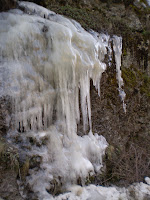It seemed like the whole town was out in the rain on Friday, Jan. 6 for the celebration of Bogoyavlenie (Epiphany) in Rila. The real show started around 11:30AM, after the priests finished the indoor service and came down from the hillside church, crossed the central square, and then made their way to one of the several bridges across the Rila river, leading the procession across it. Then they set up shop on the other side, blessing all comers with holy water, which the residents also bottled for future use (self-blessing?). Down at the river itself, some of the town’s younger male residents gathered in anticipation of the ritual cross throwing. Whoever brought the cross up from the water would lead the door-to-door blessings the following day (Ivanov den, celebrating John the Baptist) and would receive various gifts from the local households for doing so. About a dozen lads were ready to get wet and shoved around a bit in the river for this honor as their neighbors observed from on and around the bridge. I didn't see an ambulance standing by, but representatives of the local law enforcement were on hand in case someone got…cross.

Waiting for the cross toss
The cross has been tossed
Up by the riverside
The holy-water table, the main priest presiding. Residents hurry to get blessed,
stock up on holy water, and join the procession back toward the church
After the show we walked up the hill to the church because we’d never been by there when it was actually unlocked. The main priest (in yellow in the photo above) was just on his way out as we debated whether the icons around the entrance were by the same group of Samokov iconographers that did the church at the Rila Monastery up the road. We asked him, and his reply, hurried but not unfriendly, was, “It’s written somewhere over there,” motioning in the general direction of the church before hopping into a well-used black Ford compact and driving off. Oh, he’s got more gigs today, I thought. Of course – every town around here’s got a river somewhere waiting to be…crossed.
When we stopped by a friend’s place the next day to pick up some pickled cabbage and try some homemade red wine, who should come by but the cross-bearers, making their blessing rounds. One (at right in photo below) crossed us each in turn with a bough of boxwood dipped in holy water, then held out the cross (the very same one that he had retrieved from the river) for us to kiss. His assistant (in red jacket, at left in photo below) held the broad metal plate that we put coins and banknotes on in thanks. Our host made an additional gift – a two-liter bottle of his wine. I was sad to see it go, thinking naively that this was his only bottle. Imagine my relief when I looked back at the table, and another one had already appeared in its place.
OK, the wine bottle was on the floor...

























